The International Airport of Gran Canaria is 20 kilometres from Las Palmas de Gran Canaria and can be reached by taking the motorway Autopista GC-1, which allows you to make the journey in less than 20 minutes.
You can also arrive in Las Palmas de Gran Canaria by sea. The Puerto de la Luz and Las Palmas port is a base for cruise ships between the months of October and June.
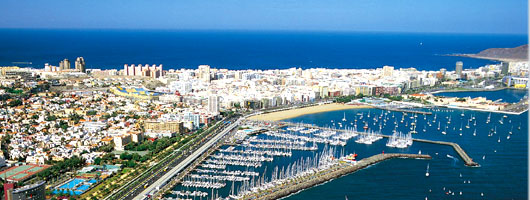
The city has two main bus stations, one in San Telmo Park and the other in Santa Catalina Park. The bus services leaving from these two places will take you to all the suburbs of the city, as well as to the other municipalities of the island.
To see the historic centre visitors should go to the popular area of Vegueta where some of the most important historical buildings have been standing for the past five hundred years: the chapel of San Antonio Abad, the Plaza de Santa Ana bordered by the Casas Consistoriales, the Obispado, the Casa Regental and Santa Ana Cathedral.
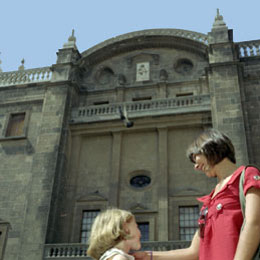
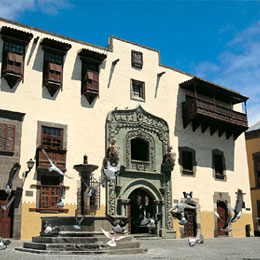
Vegueta also houses museums such as Casa de Colón (Christopher Columbus museum), where you can learn about the most interesting aspects of Columbus´ trips to America and his stopovers in Las Palmas de Gran Canaria. The Museo Canario contains the historic relics left by the former inhabitants of the island. The Museo de Arte Sacro (Museum of Sacred Art) also offers visitors an exhibition of several religious works. In contrast to the historic buildings in Vegueta, you can also visit the Centro Atlántico de Arte Moderna (modern art gallery) which is one of the most interesting avant-garde displays of works by Spanish artists.
It is worth missing a few hours of sunning on the beach to visit samples of traditional architecture, patios full of plants and plazas such as Pilar Nuevo, Santo Domingo and Espíritu Santo presided over by a beautiful stone fountain, wooden balconies and cobbled streets.
Before leaving Vegueta you must visit the Guiniguada theatre and take a walk through the old market that dates back to 1854.
After the founding of the city, the buildings started to extend along the other side of the Guiniguada ravine becoming what is now known as Triana, originally a maritime and commercial area. Here, the visitor can enjoy a pleasant walk along the main street called calle Mayor de Triana, where there are several buildings of great artistic and historical value. Also in this area is the San Telmo Parkwith several notable constructions, including the chapel of San Telmo, a pavilion of modernist design with a café, and a bandstand, also in the modernist style and one of these is dedicated to Music.
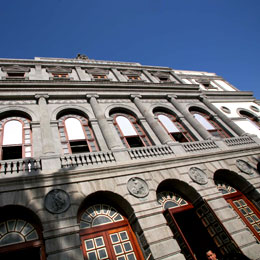
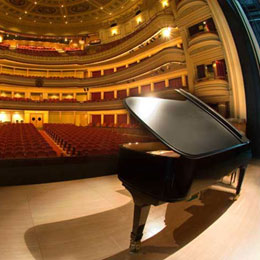
The theatre Teatro Pérez Galdós, of italian inspiration, is one of the most emblematic buildings of the city. One of the meeting points in Triana is the Plaza Hurtado de Mendoza and the Plaza Cairasco, with two notable buildings: the Hotel Madrid and the Gabinete Literario, both in the neoclassical style and with modernist decoration. Sit in one of the terrace bars and enjoy the relaxing atmosphere of the Plaza Cairasco.
Another of the most interesting architectural elements in the area surrounding Triana is the Edificio Quegles built in 1900. Also located in Triana is the Casa Museo Pérez Galdós. This museum contains a documental archive with the biographical and literary research on the novelist, Pérez Galdos, who was born in this very house.
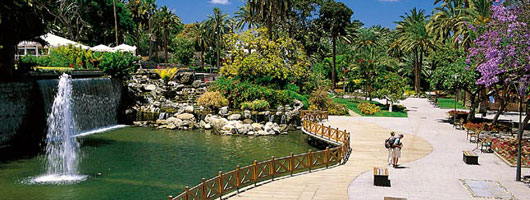
In the centre of the city, close to the Alcaravaneras beach is the Parque Doramas. Its gardens, recently reformed, are home to species of autochthonous plants. Within the park there are three important buildings. The Pueblo Canario is a sample of traditional Canary architecture and houses the Museo Néstor dedicated to Nestor Fernández de la Torre, a modernist painter and one of the most significant figures of the Archipelago. The historic Hotel Santa Catalina, built in colonial style and inaugurated in 1890, completes this architectural group located in the centre of the city.
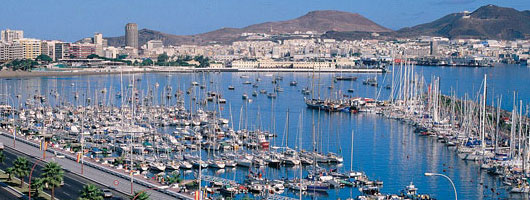
The Muelle Deportivo marina is the largest dock for private seafaring craft in the Canary Islands. It is located in the Avenida Marítima in front of the Hotel Santa Catalina. One of the most important transatlantic regattas, the Atlantic Rally for Cruisers (ARC), starts at this marina joining Gran Canaria to Santa Lucía in the Caribbean.
In the port area of the city is one of its most emblematic parks: el Parque Santa Catalina, an example of life in the streets. Here you can find the Museo de la Ciencia (Science Museum) and the Edificio Miller (Miller Building), both of which hold cultural activities. Parque Santa Catalina is also the key centre of Carnaval and the Dance and Theatre Festival celebrated during summer.
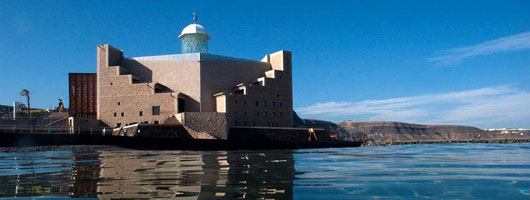
Alfredo Kraus Auditorium presides over the Las Canteras beach from one of its extremes. The main music concerts and international congresses are held here.
If you want to enjoy the scenic beauty and Canary architecture of the municipality, take yourself to the residential area of Tafira. This is also the location of the botanic gardens Jardín Botanico Viera y Clavijo. The gardens bring together the most important autochthonous plants of the archipelago.

For one of the most spectacular and enjoyable walks visit the Caldera de Bandama, a dormant volcanic crater. The diameter of the crater is 1 kilometer and it is 200 meters deep. The lava flow from the crater formed the Bandama peak from which there is a spectacular view.
Las Palmas de Gran Canaria is one of the few capital cities of Spain which has kilometres of beach. Added to this, are the excellent climatic conditions of the island, which allow the beach to be used all year round.
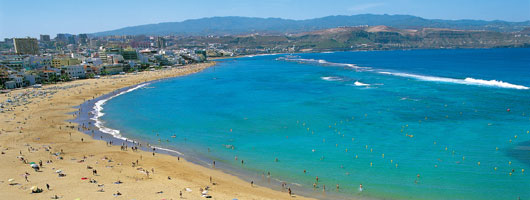
The main beach, and the one where most tourists go, is la Playa de Las Canteras. Three kilometres of golden sand go hand in hand with three kilometres of pleasant walkway, where all types of services are available: hotels, restaurants, bars and terrace bars. At nightfall, the beach becomes an excellent place for practising all types of sport, or for a relaxing stroll.
La Playa de El Confital lies at the foot of the mountains like an extension of the sea. Here the sun was used to evaporate the pools of water where some saltworks were established. Along this coast the best straight surfing wave in Europe is found.

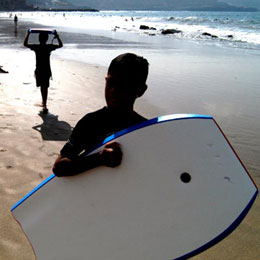
La Playa de Las Alcaravaneras, beside the Muelle Deportivo marina, is very close to the centre of the city. With nearly 1000 metres of golden sand, it is bordered by the two yatch clubs of the city. This is the best beach for practising aquatic sports such as sailing, as it is sheltered by the wharves of the Puerto de la Luz port.
Finally, la Playa de La Laja is on the way out of the city heading to the south of the island. It is a black sand beach with a pleasant seaside walk and a dike for protection from the waves. It is an area with excellent surfing and fishing conditions.
Las Palmas de Gran Canaria has four large commercial centres: Las Arenas, La Ballena, 7 Palmas and El Muelle as well as the shopping areas of Triana and Mesa y López. The shops, leisure and service centres offer a wide range of products and prices. In the area around Santa Catalina Park there are small businesses specialising in sound and image equipment.
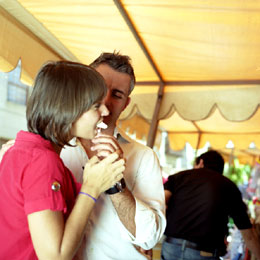
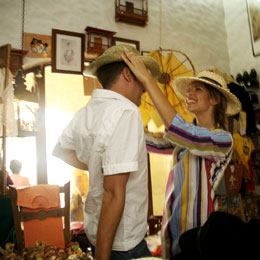
If visitors wish to buy traditional products or products from the island there are four markets to choose from: Vegueta, el Puerto, Alcaravaneras and Altavista. Those looking for craftwork can visit the markets celebrated on Sundays in Vegueta or go to the Pueblo Canario. The FEDAC shop in Triana, open during shopping hours, is the official outlet for craftwork. An antique market is held on the first Sunday of each month in the Santa Catalina Park.
In Las Palmas de Gran Canaria you can try a large variety of traditional dishes that make up the Canary Islands gastronomy, from sancocho, made with a fish called “cherne”, to several meat dishes, including carajacas (a liver dish) accompanied by papas arrugadas con mojo (wrinkled potatoes with “mojo” sauce), suckling pig, marinated rabbit, leg of pork, ropa vieja (meat with chick peas and vegetables) or goat.
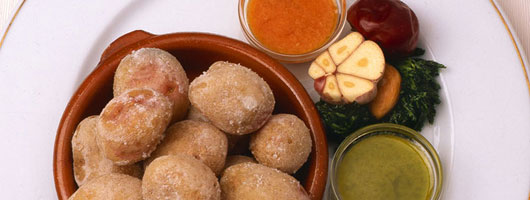
Don’t leave the city without trying one of these traditional dishes or tasting the pastries and confectionery that come from the villages in the interior of the island, such as the suspiros de Moya, bienmesabe de Tejeda or the delicious cakes made by the Cistercian nuns in Teror.
In Las Palmas de Gran Canaria ‘taperío’, trying different tapas or aperitifs, is also very popular. The areas of Vegueta, Triana, el Puerto and Tafira are the usual places for trying some of these tapas at small terrace bars.
Las Palmas de Gran Canaria: Download Tourist Brochure | Map | Podcast | E-book |
Gran Canaria extends a warm welcome to cruisers
Accommodation: Las Palmas de Gran Canaria
More options for your trip
If you would like to go on daytrips around the historical districts of Las Palmas de Gran Canaria, just contact Tripgrancanaria
Would you like to take a photo-tour around less familiar locations in the city? Learn photography the fun way with Pentraprisma
HandyVisits organizes mystery tours with its "Vegueta the Canary treasure" excursion.
Activities, excursions and guided tours in Las Palmas de Gran Canaria with Lowcosttours.com